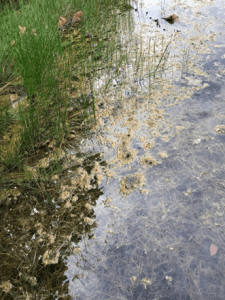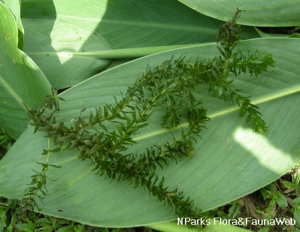A Trek Through History
Imagine yourself trekking through a freshwater wetland forest. Each step is harder than the last as your feet sink deeper into the soft mud. The whining of mosquitoes distracts you from the sticky feeling between your toes. Absentmindedly, you wave the pesky insects away and prop yourself up using a nearby branch, continuing your trek through the dense wetlands.
While this experience is almost unheard of in modern Singapore, taking part in these wild treks were possible in the mid 19th century at the historic site of the Learning Forest in Singapore Botanic Gardens (Figure 1).
Figure 1. Present site of the Learning Forest (Photo from: Melody Zaccheus)
Originally, a freshwater wetland forest occupied the northern half of the Learning Forest (Er et al., 2017). Archived maps document how a natural stream in 1860 (Figure 2A) was converted into ponds in 1913 (Figure 2B), which had disappeared by 1932 (Figure 2C). To restore the freshwater habitat, the National Parks Board (NParks) and Keppel Corporation (KC) collaborated to build Keppel Discovery Wetlands (Figure 1).



Figure 2. Archived maps of the historic site of the Learning Forest in 1860 (A), 1913 (B) and 1932 (C) (National University of Singapore, n.d.).
A Journey at Keppel Discovery Wetlands
Opened in 2017, Keppel Wetlands enabled visitors to experience a unique wetland habitat right in the heart of the city. Wetlands – land areas saturated with water – are essential ecosystems that provide valuable ecosystem services (National Geographic, n.d.). Not only do Singapore’s wetlands store blue carbon and protect our coastlines, they are also critical pockets of biodiversity (NParks, 2015). Home to a variety of flora and fauna, Keppel Wetlands is evidence of the ecological treasure trove that exists in our wetlands (Figure 3 and 4).

Figure 3. Blue Dasher (Brachydiplax chalybea); listed as Least Concern in IUCN Red List (Dow, 2010); native to Singapore (Biodiversity of Singapore, n.d.) (Photo by Alvern Mak Wei Jie on 19 February 2022).

Figure 4. Common Kingfisher (Alcedo atthis); listed as Least Concern in IUCN Red List (BirdLife International, 2016) (Photo by Samuel Lee on 12 February 2022)
Diving Under the Surface
Keppel Discovery Wetlands was given its name to recognise KC’s generous donation of S$2.08 million to restore this wetland ecosystem (NParks, 2016). The project was a huge success as Keppel Wetlands welcomed over 600,000 visitors in its first year (KC, n.d.). However, in a recent field trip, the sights that greeted me looked nothing like the beautiful pictures taken on opening day (Figure 5 and 6).

Figure 5. Keppel Discovery Wetlands on opening day (31 March 2017) (Siau, 2017)


Figure 6. Keppel Discovery Wetlands on 12 January 2022 (Photos by Toh Jie Ying on 12 January 2022)
In five years, the wetlands has become overrun by Hydrilla – an invasive aquatic weed (Figure 6 and 7) (NParks, n.d). This fast-growing plant forms dense mats on the water surface, outcompeting native aquatic plants and clogging waterways (Rojas-Sandoval, 2018). Ironically, Keppel Wetlands was restored to provide clean water to Swan Lake (Er et al., 2017), which is no longer possible due to an oversight in its restoration process – the lack of maintenance. Beyond the prestige of having named a restoration area, concrete monitoring and maintenance plans should be formalised in collaborative restoration projects by NParks and other organisations. This can help NParks ascertain whether restoration aims have been achieved and inform subsequent management plans (Vaughn et al., 2010).


Figure 7. Hydrilla (Hydrilla verticillata (L.f.) Royle); listed as Least Concern in the IUCN Red List (Zhuang & Beentje, 2017); invasive species (NParks, n.d.) (Photos by NParks, n.d.)
A Murky Future?
Labelled as one of the most persistent invasive species in aquatic ecosystems, Hydrilla is almost impossible to eradicate (Vaughn et al., 2010). The future of Keppel Wetlands may seem murky, but it is important to remind ourselves that although ecological restoration is rarely an easy journey, it is not unattainable. While we may never be able to experience a wild trek through a freshwater wetland forest, let us hold onto the hope that one day, our future generations will.
Written by: Rachel Tan Xinyue
Leave a Reply